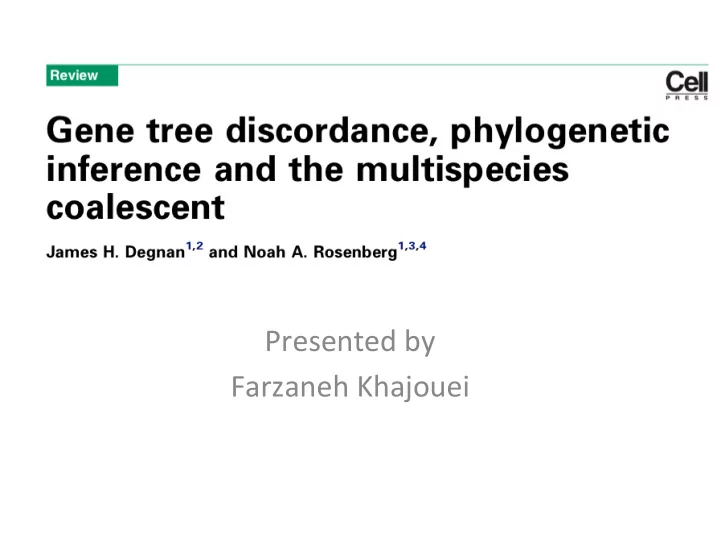

Presented ¡by ¡ ¡ Farzaneh ¡Khajouei ¡
The ¡Mul7species ¡Coalescent ¡ Generalizes ¡the ¡Wright-‑Fisher ¡model ¡of ¡gene7c ¡driA ¡ • Constant ¡effec7ve ¡popula7on ¡size ¡(Ne) ¡ ¡ • Non-‑overlapping ¡genera7ons ¡ • Neutral ¡evolu7on ¡for ¡the ¡loci ¡modeled ¡ • No ¡structure ¡within ¡popula7ons ¡ • Random ¡joining ¡of ¡lineages ¡backward ¡in ¡7me ¡ ¡ The ¡coalescent ¡model ¡approximates ¡the ¡process ¡of ¡choosing ¡random ¡parents ¡ backward ¡in ¡7me ¡when ¡the ¡popula7on ¡size ¡is ¡large ¡rela7ve ¡to ¡the ¡number ¡of ¡ sampled ¡lineages. ¡ ¡ ¡ ¡ ¡ ¡
Incomplete ¡Lineage ¡Sor7ng ¡(ILS) ¡ ¡ Failure ¡of ¡two ¡or ¡more ¡lineages ¡in ¡a ¡popula7on ¡to ¡coalesce, ¡leading ¡to ¡the ¡ possibility ¡that ¡at ¡least ¡one ¡of ¡the ¡lineages ¡first ¡coalesces ¡with ¡a ¡lineage ¡from ¡ a ¡less ¡closely ¡related ¡popula7on. ¡ ¡ Typical ¡with ¡shallow ¡species ¡trees, ¡where ¡taxa ¡are ¡closely ¡related ¡and ¡the ¡ • root ¡of ¡the ¡tree ¡is ¡recent ¡ ¡ In ¡deep ¡phylogenies, ¡for ¡some ¡combina7ons ¡of ¡branching ¡paQerns ¡and ¡ • branch ¡lengths, ¡lineages ¡are ¡likely ¡to ¡sort ¡in ¡a ¡way ¡that ¡violates ¡monophyly ¡ of ¡lineages ¡for ¡a ¡species ¡deep ¡in ¡the ¡tree ¡ ¡ ¡ Different ¡usage ¡of ¡the ¡term ¡ILS ¡ – Par7cular ¡types ¡of ¡genealogical ¡paQern ¡ – A ¡process ¡that ¡explains ¡the ¡gene ¡tree ¡discordance ¡detected ¡in ¡gene7c ¡data ¡ – When ¡polymorphisms ¡exist ¡at ¡a ¡a ¡locus ¡in ¡descendant ¡popula7on ¡ ¡ Hemiplasy : ¡The ¡gene ¡tree ¡incongruence ¡specifically ¡caused ¡by ¡incomplete ¡ lineage ¡sor7ng ¡when ¡ancestral ¡polymorphism ¡is ¡retained ¡through ¡specia7on ¡ events. ¡ ¡ ¡
Gene ¡Tree ¡and ¡Species ¡Tree ¡ Discordance ¡ ü Incomplete ¡Lineage ¡Sor7ng. ¡ ¡ • Horizontal ¡Gene ¡Transfer ¡ • Gene ¡Duplica7on ¡and ¡Loss: ¡ • ¡Hybridiza7on ¡ ¡ – Hybridiza7on ¡affects ¡whole ¡genomes, ¡whereas ¡HGT ¡ typically ¡affects ¡only ¡small ¡DNA ¡segments. ¡ ¡ • Recombina7on ¡
Anomalous ¡Gene ¡Tree ¡(AGT) ¡ A ¡gene ¡tree ¡topology ¡that ¡is ¡more ¡probable ¡than ¡the ¡gene ¡tree ¡ topology ¡that ¡matches ¡the ¡species ¡tree ¡topology ¡ ¡ AGT ¡arise ¡with ¡an ¡assignment ¡of ¡species ¡tree ¡branch ¡length ¡for ¡species ¡ tree ¡topology ¡with ¡at ¡least ¡five ¡taxa, ¡and ¡also ¡for ¡asymmetric ¡four-‑ taxon ¡tree ¡ ¡ • Long ¡branches, ¡lineages ¡are ¡likely ¡to ¡have ¡coalesced ¡within ¡ each ¡popula7on ¡(5Ne) ¡ • Shorter ¡branches, ¡mul7ple ¡gene ¡lineages ¡tend ¡to ¡persist ¡into ¡ deeper ¡por7ons ¡of ¡the ¡species ¡tree ¡ ¡ ¡ ¡
With ¡5 ¡or ¡more ¡species, ¡any ¡species ¡tree ¡topology ¡produces ¡at ¡ least ¡one ¡anomalous ¡gene ¡tree. ¡ ¡ A B C D E D E C A B Species ¡Tree ¡ Gene ¡Tree ¡
Gene ¡tree ¡probabili7es ¡under ¡the ¡ mul7species ¡coalescent ¡model ¡ The ¡probability ¡that ¡ i ¡lineages ¡have ¡ j ¡ ancestors ¡at ¡ T ¡coalescent ¡7me ¡units ¡ ( T ¡= ¡ t ¡/ ¡ N ¡ ) ¡in ¡the ¡past ¡is ¡ a [k] ¡= ¡a(a-‑1)…(a-‑k+1) ¡ a (k) ¡ = ¡a(a+1)…(a+k-‑1) ¡
Coalescent ¡Histories ¡for ¡a ¡five ¡taxa ¡Tree ¡ Gene ¡tree ¡ Species ¡tree ¡ 1 2 3 4 A B C D E A C B D E ((AC),B) ¡ (D,E) ¡ (((AC)B,(DE)) ¡ Probability ¡ (A,C) ¡ g ij ( T ) ¡is ¡the ¡probability ¡that ¡i ¡lineages ¡coalesce ¡to ¡j ¡lineages ¡during ¡7me ¡ T ¡
Species ¡Tree ¡Inference ¡ • Democra7c ¡vote: ¡ the ¡most ¡commonly ¡occurring ¡gene ¡tree ¡ topology ¡is ¡used ¡as ¡the ¡es7mate ¡of ¡the ¡species ¡tree. ¡ – Converges ¡on ¡an ¡incorrect ¡es7mate ¡when ¡four ¡or ¡more ¡taxa ¡are ¡ present ¡and ¡an ¡AGT ¡exists ¡ – sensi7ve ¡to ¡sampling ¡varia7on ¡for ¡small ¡numbers ¡of ¡loci ¡ ¡ • Consensus: ¡ construct ¡a ¡tree ¡that ¡summarizes ¡input ¡trees ¡ defined ¡on ¡the ¡same ¡set ¡of ¡taxa ¡ ¡ • Concatena7on: ¡ all ¡sampled ¡genes ¡are ¡concatenated ¡for ¡ each ¡taxon ¡and ¡are ¡then ¡analyzed ¡ ¡ • Maximum ¡Likelihood ¡
Species ¡Tree ¡Inference ¡ New ¡Approaches ¡ • Minimizing ¡the ¡number ¡of ¡deep ¡coalescent ¡ ¡ • Maximum ¡likelihood ¡(ML): ¡ a ¡species ¡tree ¡likelihood ¡is ¡ obtained ¡by ¡condi7oning ¡on ¡the ¡gene ¡trees ¡at ¡each ¡locus ¡and ¡summing ¡ over ¡all ¡possible ¡sets ¡of ¡gene ¡trees ¡ ¡ • Bayesian ¡approach ¡ ¡ ¡
Summary ¡ • A ¡species ¡tree ¡can ¡disagree ¡with ¡the ¡gene ¡tree ¡that ¡it ¡is ¡most ¡likely ¡to ¡ produce ¡ • Conflicts ¡in ¡gene ¡tree ¡and ¡species ¡tree ¡can ¡give ¡informa7on ¡about ¡how ¡ the ¡species ¡is ¡evolved. ¡ ¡ • Conflic7ng ¡gene ¡genealogies ¡can ¡be ¡used ¡to ¡infer ¡ancestral ¡popula7on ¡ parameters ¡ • popula7on ¡size ¡ ¡ • divergence ¡7mes ¡ • The ¡number ¡of ¡coalescent ¡histories ¡increases ¡quickly ¡ ¡ • This ¡severe ¡discordance ¡only ¡gets ¡worse ¡with ¡more ¡taxa ¡ • Some ¡algorithms ¡can ¡infer ¡the ¡correct ¡species ¡tree ¡even ¡when ¡gene ¡ tree ¡discordance ¡is ¡extreme ¡ ¡ ¡
Outstanding ¡Ques7ons(1) ¡ i. ¡Which ¡species ¡tree ¡es7mators ¡from ¡mul7locus ¡data ¡are ¡sta7s7cally ¡ consistent, ¡even ¡when ¡there ¡are ¡AGTs? ¡Among ¡consistent ¡algorithms, ¡ which ¡offer ¡the ¡fastest ¡convergence ¡to ¡the ¡species ¡tree? ¡ ¡ ii. Do ¡computa7onally ¡tractable ¡ML ¡algorithms ¡exist ¡that ¡consistently ¡infer ¡ the ¡species ¡tree ¡while ¡accoun7ng ¡for ¡varia7on ¡among ¡gene ¡trees? ¡ ¡ iii. What ¡are ¡the ¡effects ¡of ¡taxon ¡sampling ¡for ¡methods ¡of ¡inferring ¡species ¡ trees? ¡Do ¡improvements ¡in ¡gene ¡tree ¡es7ma7on ¡owing ¡to ¡increased ¡ taxon ¡sampling ¡lead ¡to ¡improvements ¡in ¡species ¡tree ¡es7ma7on? ¡ ¡ iv. What ¡is ¡the ¡computa7onal ¡complexity ¡of ¡the ¡evalua7on ¡of ¡gene ¡tree ¡ probabili7es? ¡For ¡a ¡given ¡number ¡of ¡taxa, ¡which ¡gene ¡tree-‑species ¡tree ¡ combina7on ¡maximizes ¡the ¡number ¡of ¡coalescent ¡histories, ¡and ¡what ¡is ¡ this ¡maximum? ¡If ¡the ¡gene ¡tree ¡matches ¡the ¡species ¡tree, ¡which ¡ topologies ¡minimize ¡and ¡maximize ¡the ¡number ¡of ¡coalescent ¡histories? ¡ ¡ v. Is ¡there ¡a ¡way ¡of ¡compu7ng ¡gene ¡tree ¡probabili7es ¡that ¡does ¡not ¡ depend ¡linearly ¡on ¡the ¡number ¡of ¡coalescent ¡histories? ¡ ¡
Recommend
More recommend